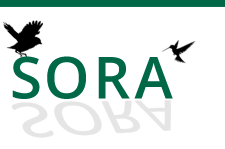Second Nestings in the Wren-tit
Online Full Text
Second Nestings in the Wren-tit.-In her thorough study of territory and the reproductive cycle of the Wren-tit (Chamaea fasciuta), Erickson (Univ. Calif. Publ. Zool., 42, 1938:282ff.) came to the conclusion that “only one brood is raised” each season. Pairs which successfully fledged young were watched, but no evidence of repetition of the nesting cycle, once it was completed, was found. Of course there is repetition of effort when eggs or even well grown young are lost, as in a great many species of birds. There is no reason to doubt that Erickson’s observations were correct with respect to the population she studied near Berkeley, California, for she was thoroughly acquainted with events taking place in the lives of the many pairs under her surveillance.
Because this conclusion about second nestings was in mind, I was particularly moved to follow up clues indicating a contrary situation when these came to my notice in the course of field work in June of 1943. While collecting in ceanothus and manzanita brush two miles east of Hayfork, Trinity County, California, on June 17, I encountered occasional, well spaced pairs of Wren-tits of the race LenshawL In an effort to obtain a few adult birds I called a family group very close to me in the bushes. They were watched for some time and at least two fully grown young in unworn juvenal plumage were seen; they apparently had full-length tails. The adult male was taken after observing him give the accelerated song-trill as described for this sex by Erickson (p. 302). The female was chattering close to the young and iinally was singled out from them and taken. The young were not collected as they seemed well enough developed to care for themselves even though they were travelling in close company with their parents. Upon dissection the female proved to have one ovum in the oviduct and three empty follicles and one large ovum 7 mm. in diameter in the ovary. She was thus near completion of a second set of four eggs while guarding full-grown young. She had an old brood patch also. Another pair was taken on this date, the female of which likewise was laying, but I could not be sure of associated young.
Although the evidence was adequate to indicate at least one instance of a second breeding cycle following a successful first cycle, one item of information was perplexing. The testes of the male parent of the brood measured but 2% mm. in length, much too small, it seemed, to be in functional state. Was there chance of a fertile set of eggs in this second reproductive cycle? Later at Hyampom, Trinity County, on June 26, a mated pair was taken and the male had testes but 3 mm. long whereas the female was laying. It should be noted that in most if not all passe&es the testis when reproductively functional attains greater length; for example, Bewick Wrens in breeding condition measure 6-7 mm., Bush-tits, 4-6, Gnatcatchers, 5-6, Creepers, 6, and Mountain Chickadees, 6-9. All these species are smaller birds than Wren-tits. Subsequent opportunity to examine five male Wren-tits (races intermediu and rufula) taken in May in the height of the nesting season showed testes ranging from 8 to 5 mm. in length, but only one at the maximum figure. As a consequence it is now thought that the males taken with laying females in June in Trinity County were probably at or close to normal breeding size of testis. The significant fact deserves emphasis, however, that male Wren-tits show a remarkably weak gonad development compared with other members of the Passeriformes and with related types like tits and wrens. One other peculiar circumstance about them also comes to notice. A bare brooding area appears in the male during incubation; it is not highly vascular as in the females. However, in incubating males of other passerines which I have noted there is little or no development of a breast area devoid of down.-ALDEN H. MILLER, Museum of Vertebrate Zoology, Berkeley, California, October 7, !944.
Creative Commons License
Recommended Citation
Miller, Alden H.
(1944)
"Second Nestings in the Wren-tit,"
Condor: Vol. 46
:
Iss.
6
, Article 12.
Available at:
https://digitalcommons.usf.edu/condor/vol46/iss6/12

